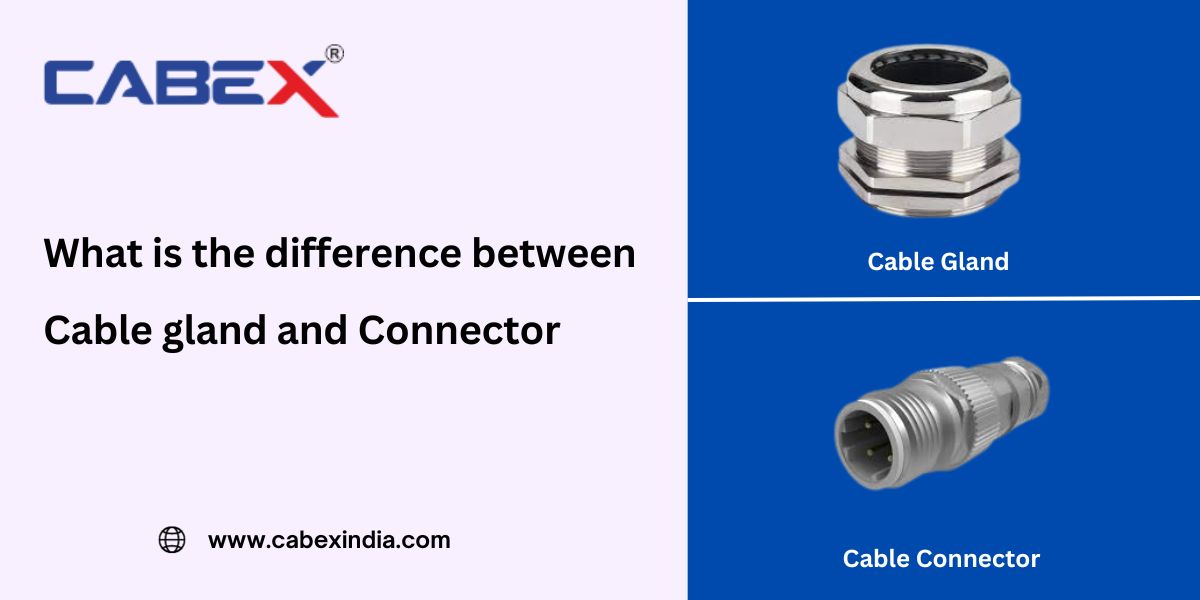The difference between cable gland and connector lies in their distinct functions within electrical systems. A cable gland, also known as a cable connector. Secures and seals the end of an electrical cable, providing strain relief and protection against environmental factors. It is crucial in applications where cables need secure termination. On the other hand, a connector is a device that joins electrical circuits. Allowing for the connection and disconnection of conductors. Connectors play a key role in establishing and breaking electrical connections between devices or components. In essence, cable glands focus on cable termination and environmental protection, while connectors facilitate electrical connections within a system.
What is cable gland
Cable Gland, also known as a cable fitting, used to secure and protect the end of an electrical cable. Where it enters a piece of equipment. The primary purpose of a cable gland is to provide a secure and reliable connection. Offering strain relief to prevent the cable from being pulled or twisted, and to seal. The cable entry point against environmental elements.
Key features of cable glands :
- Strain Relief: Cable glands prevent undue stress on the cable by securing it in place. This is particularly important in industrial settings or places where cables may be subject to movement or tension.
- Environmental Protection: Cable glands help seal the entry point of the cable, protecting it from dust, moisture, and other contaminants. This is crucial for maintaining the integrity and functionality of the electrical connections.
- Variety of Types: Cable glands come in various types to suit different applications. For example, there are glands designed for armored cables. Those suitable for hazardous environments (explosion-proof glands), and weatherproof glands for outdoor use.
- Materials: Cable glands are often made of materials that resist corrosion and provide durability. Common materials include metal, plastic, or a combination of both.
- Installation: Cable glands are designed to be easily installed on the cable and the equipment. They typically have a threaded design that allows them to be screwed onto the equipment, providing a secure and tight connection.
Cable glands are widely used in various industries, including manufacturing, telecommunications, energy. Wherever electrical cables need to be terminated securely and protected against environmental factors.
What is cable connector
The term ” cable connector” generally refers to a type of connector specifically designed for use in industrial settings. Industrial environments often have unique requirements and challenges. Such as exposure to harsh conditions, heavy machinery, and a need for reliable and robust electrical connections. Industrial cable connectors are designed to meet these challenges and ensure the safe and efficient transfer of electrical signals or power in industrial applications.
Key features of cable connectors :
- Durability: Industrial cable connectors are typically built to withstand tough conditions, including exposure to dust, moisture, chemicals, and mechanical stress. They are often constructed from materials that resist corrosion and damage.
- Sealing: Many industrial environments require connectors. That can provide a high degree of ingress protection (IP) to prevent the entry of dust and water. Sealing features help maintain the integrity of electrical connections in challenging environments.
- Secure Connections: Industrial cable connectors are designed to ensure a secure and reliable electrical connection. This is important for maintaining the continuity of power or signals in industrial processes where interruptions can have significant consequences.
- Variety of Types: Industrial cable connectors come in various types to accommodate different applications. These may include plug and socket connectors, multi-pin connectors, circular connectors, and more.
- Resistance to Environmental Factors: Depending on the specific industrial application, cable connectors may need to resist factors. Such as extreme temperatures, vibrations, or electromagnetic interference.
- Easy Installation and Maintenance: Industrial connectors are often designed for easy installation and maintenance, allowing for quick and efficient connections and disconnections during equipment setup, repair, or replacement.
These connectors play a crucial role in ensuring the reliability and safety of electrical connections. Where the demands on equipment and infrastructure are often more rigorous than in other environments.
Key difference between cable gland and connector
Cable connectors and cable glands are essential components in electrical systems used in industrial settings. While both play crucial roles in ensuring reliable and secure electrical connections, they serve distinct functions and have key differences in their design and application.
Cable Connector:
Cable Connector are devices specifically engineered for the reliable transmission of electrical signals or power in industrial environments. These connectors are designed to withstand the challenging conditions often found in industrial settings, where equipment is exposed to dust, moisture, vibrations, and other harsh elements. Here are some key characteristics of industrial cable connectors:
- Versatility: Industrial cable connectors come in various types to accommodate different needs. Plug and socket connectors, multi-pin connectors, and circular connectors are common varieties. The choice of connector type depends on factors such as the type of equipment, the complexity of the electrical system, and the specific requirements of the industrial application.
- Durability: One of the primary distinctions of industrial cable connectors is their durability. These connectors are constructed from robust materials, often resistant to corrosion and damage. This durability ensures a longer lifespan and reliable performance in demanding industrial environments.
- Ingress Protection: Industrial connectors typically offer a high degree of ingress Protection (IP) to shield against dust, water, and other environmental factors. This is crucial in environments where exposure to moisture and contaminants is common.
- Secure and Reliable Connections: Maintaining a secure electrical connection is paramount in industrial applications. Industrial cable connectors are designed to provide a stable and reliable connection, minimizing the risk of interruptions in power or signal transmission. This reliability is vital in industrial processes where even brief interruptions can have significant consequences.
- Resistance to Environmental Factors: Industrial environments can expose connectors to extreme temperatures, vibrations, and electromagnetic interference. Industrial cable connectors are engineered to resist these environmental factors, ensuring consistent performance under challenging conditions.
Cable Gland:
Cable glands, also known as cable connectors or cable fittings, serve a different but equally important role in industrial settings. They are primarily responsible for securing and protecting the end of electrical cables where they enter equipment. The key features of cable glands include:
- Strain Relief: Cable glands provide strain relief by securing cables in place. This is crucial in industrial environments where cables may be subjected to movement, tension, or mechanical stress. Strain relief helps prevent damage to the cable and ensures a longer lifespan.
- Environmental Sealing: In addition to strain relief, cable glands seal the cable entry point to protect against environmental elements such as dust, moisture, and gases. This environmental sealing is essential for maintaining the integrity of the cable and preventing damage that could result from exposure to harsh conditions.
- Types for Different Applications: Cable glands come in various types to suit different applications. For instance, there are armored cable glands for use with armored cables, explosion-proof glands for hazardous environments, and weatherproof glands for outdoor applications.
- Easy Installation: Cable glands are designed for easy installation on both the cable and the equipment. They typically have a threaded design that allows them to be securely attached, providing a tight and reliable connection.
Industrial cable connectors focus on facilitating the transmission of electrical signals or power with durability and reliability in industrial environments, cable glands are dedicated to securing and protecting cables at their entry points, offering strain relief and environmental sealing.
People also likes: What is the Difference Between MV Cable and HV Cable?
Conclusion
In conclusion, the difference between cable gland and connector is fundamental in understanding their respective roles within electrical systems. Cable glands stand as guardians at the point where electrical cables enter equipment, providing essential functions such as strain relief and environmental sealing. Their design caters to the protection of cables against dust, moisture, and other external factors, ensuring the longevity and integrity of the electrical connections. On the other hand, connectors serve as the bridges that link electrical circuits, allowing for the seamless transmission of power or signals.
FAQ :
Q1: What is a cable gland, and what is its primary function?
Ans: A cable gland, also known as a cable connector, is a device designed to secure and protect the end of an electrical cable where it enters a piece of equipment.
Q2: What materials are cable glands typically made of?
Ans: Cable glands are often constructed from durable materials such as metal or plastic, or a combination of both.
Q3: What is a cable connector, and how does it differ from a cable gland?
Ans: A cable connector is a device that joins electrical circuits together, facilitating the connection and disconnection of electrical conductors.
Q4: How do cable glands provide environmental protection?
Ans: Cable glands provide environmental protection by sealing the entry point of the cable, preventing the ingress of dust, moisture, and other contaminants.
Q5: Can cable glands and connectors be used interchangeably?
Ans: No, cable glands and connectors serve different purposes and are not interchangeable. Cable glands focus on securing and protecting cables, while connectors are designed for establishing electrical connections.






